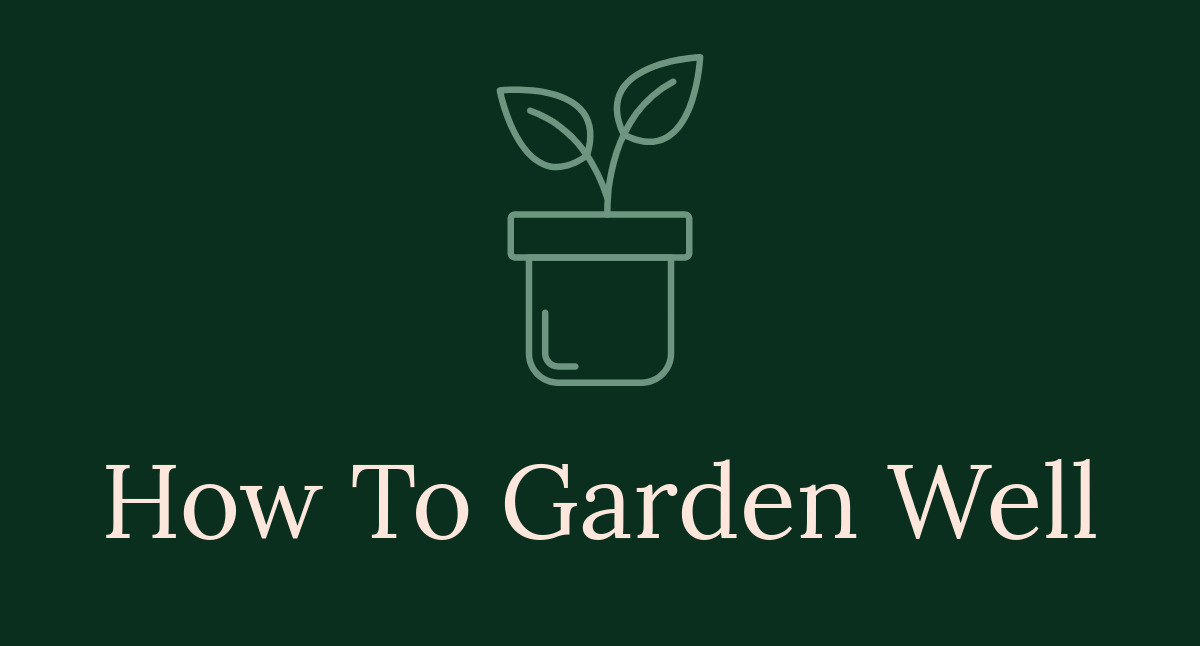
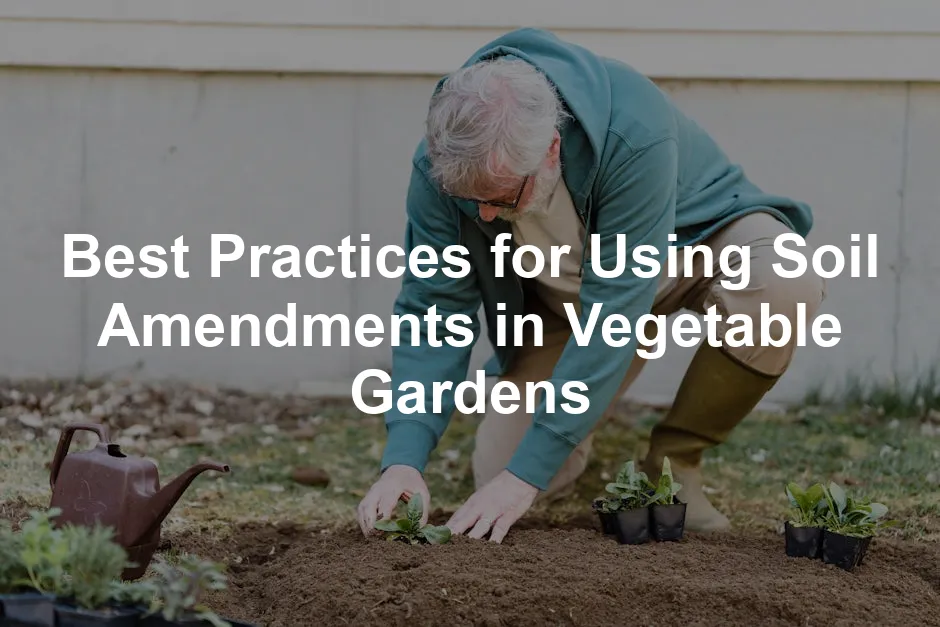
Best Practices for Using Soil Amendments in Vegetable Gardens
Common organic amendments include:
- Compost: Adds nutrients and improves soil texture.
- Manure: Rich in nutrients but must be well-aged to avoid burning plants.
- Leaf Mold: Improves moisture retention and fosters beneficial organisms.
In contrast, common inorganic amendments include:
- Lime: Raises soil pH in acidic soils.
- Gypsum: Enhances soil structure and adds calcium.
- Synthetic fertilizers: Provide a quick nutrient boost but can harm soil health if misused.
Statistics show that around 60% of gardeners prefer organic amendments, valuing their long-term benefits. Yet, many still rely on inorganic options for immediate results. Think about your gardening philosophy when choosing the right amendments for your needs. Your soil health will thrive when you make informed decisions.
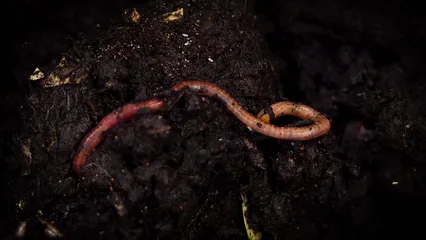
Best Practices for Applying Amendments
Timing and Method of Application
Timing is key when applying soil amendments. The best times to amend your soil vary by season. In spring, mix amendments into the soil before planting. This allows nutrients to integrate well with the soil. Fall is also an excellent time to add organic matter. It gives materials time to decompose over winter. Don’t forget to protect your hands with some quality Gardening Gloves!
Different methods exist for applying amendments. Mixing involves incorporating them directly into the soil. This is effective for improving overall soil health. Layering is another method where amendments are placed on top. This is ideal for maintaining soil structure while gradually enriching it. Top-dressing is similar, applying a thin layer without disturbing the soil too much.
Proper depth and coverage are vital. Aim for a depth of about 2 to 4 inches for most amendments. For clay soils, mixing deeper helps break up compaction. Sandy soils benefit from amendments too, but focus on surface application to improve moisture retention.
Statistics suggest that a 50% volume increase of organic amendments can enhance productivity significantly. This applies well to raised beds or garden plots. Create a schedule for when to apply amendments based on your gardening routines. Consistency leads to healthier soil and better vegetable yields.
Recommended Amendment Rates
Applying the right amount of soil amendments is crucial. Too little won’t benefit your plants, while too much can harm them. Start with a soil test to determine nutrient levels and pH. This way, you can tailor amendments to your garden’s specific needs. If you’re looking for a great soil mix, check out Planting Soil Mix to give your plants a solid start!
For compost, a common recommendation is to apply 1 to 3 inches. Mix it into the top 6 inches of soil. This method works well for most vegetables. Aged manure can be added at a rate of about 20% of the total soil volume.
Over-amending can lead to nutrient burn. Signs include yellowing leaves and stunted growth. Keep an eye out for these symptoms. Aim for balance to keep your garden healthy.
Statistics show that different vegetables thrive with specific amendment ratios. For instance, tomatoes prefer a nitrogen-rich mix, while root crops like carrots do well with balanced nutrients.
Understanding these rates helps maintain nutrient balance. Healthy soil supports robust plants. Remember, always adjust based on soil test results to ensure your amendments meet the specific needs of your garden.
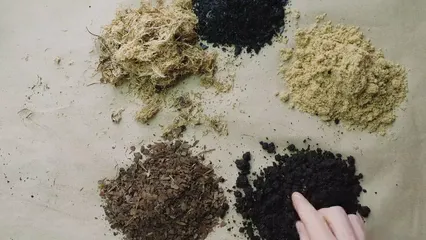
Avoiding Common Mistakes
Many gardeners make simple errors when using soil amendments. One common mistake is applying fresh manure without composting it first. This can lead to pathogen risks and nutrient imbalances. Always ensure manure is well-aged before use.
Ignoring soil test results is another pitfall. Skipping this step can lead to over-amending or under-amending your soil. Without knowing your soil’s needs, it’s easy to guess wrong.
Over-amending can manifest as nutrient burn, while under-amending often results in poor growth. Statistics suggest that about 30% of gardeners face issues due to common amendment mistakes. If you want to avoid this mistake, consider investing in a Soil pH Meter to monitor your soil’s condition easily!
To avoid these errors, always test your soil. Use recommended rates for amendments based on test results. This tailored approach will lead to healthier plants and better yields.
Share your experiences! Have you faced challenges with soil amendments? Your stories can help others learn from your journey.

Enhancing Soil Health Over Time
Building a Healthy Soil Ecosystem
Maintaining soil health goes beyond just adding amendments. It’s about nurturing a thriving soil ecosystem. A healthy soil ecosystem supports plant growth and increases resilience against pests and diseases. Incorporating practices like crop rotation, cover cropping, and mulching is essential for long-term success. For insights on crop rotation, see our post on understanding crop rotation for healthier vegetables.
Implementing crop rotation can significantly enhance your soil health. Learn more about crop rotation and its benefits for your garden.
Crop rotation helps prevent nutrient depletion. By alternating plant families, you reduce the risk of disease and pest buildup. For example, following nitrogen-fixing legumes with nutrient-hungry crops boosts soil fertility. Cover crops, such as Clover Seeds or Rye Seeds, enhance soil structure and prevent erosion during off-seasons. They also add organic matter when tilled into the soil, enriching nutrient content.
Organic matter is vital for maintaining soil health. It improves soil structure, moisture retention, and microbial activity. Regularly adding compost or well-aged manure increases organic material, fostering a vibrant soil ecosystem. Research shows that gardens practicing these methods see significant improvements in soil health metrics, like increased microbial diversity and nutrient levels.
As you cultivate your garden, remember these sustainable gardening practices. They contribute to a robust ecosystem that supports your vegetables. For more detailed strategies on enhancing soil health over time, explore additional resources available on this topic.
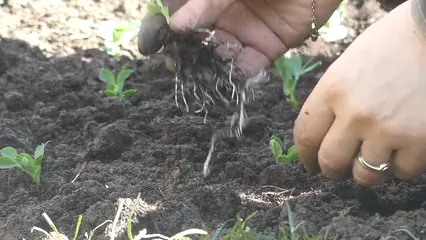
Conclusion
In summary, using soil amendments effectively is key to thriving vegetable gardens. Tailoring your approach based on soil health and plant needs ensures optimal growth. Don’t underestimate the importance of maintaining soil health through sustainable practices. Take action today, and improve your garden soil for better yields!
FAQs
What are the best soil amendments for vegetable gardens?
When it comes to choosing soil amendments, several options stand out. Compost is a fantastic all-around choice, as it enriches the soil with nutrients and improves structure. Aged manure is another great option, providing essential nutrients while enhancing moisture retention. Leaf mold improves water retention and supports beneficial microbes. For mineral needs, gypsum helps improve soil structure and add calcium. Lastly, greensand is excellent for adding potassium and trace minerals.
How often should I amend my garden soil?
The frequency of amending your garden soil depends on several factors. For most gardeners, an annual amendment in spring is ideal. If you have sandy soil, consider amending more frequently, as nutrients can wash away. In contrast, clay soils may only need amendments every couple of years. Always observe your plants for signs of nutrient deficiency, which may indicate it’s time to amend again.
Can I use fresh manure in my garden?
Using fresh manure in your garden isn’t advisable. It can contain harmful pathogens that may affect plant health. Fresh manure can also burn plants due to its high nitrogen content. Instead, opt for well-aged or composted manure. This method reduces risks and enriches your soil with nutrients while promoting healthy plant growth.
How do I know if my soil needs amendments?
To assess your soil’s health, start with a soil test. Testing reveals nutrient levels, pH balance, and organic matter content. Look for signs like poor plant growth, yellowing leaves, or compacted soil. If your plants struggle despite proper care, it’s time to consider amendments. Regular testing, ideally every three to five years, helps ensure your soil remains healthy.
What are some signs of over-amending?
Over-amending can lead to several visible symptoms. Look for nutrient burn, characterized by browning leaf edges or stunted growth. You might also notice poor water retention or a crusty surface. To correct over-amended soil, consider leaching it with water to dilute excess nutrients. Reassess your amendment rates based on soil tests to find a balanced approach.
Are there any amendments I should avoid?
Certain amendments can harm your vegetable garden. Avoid using fresh sawdust, which can tie up nitrogen as it decomposes. Peat moss is not sustainable and can lead to soil compaction over time. Rubber mulch is also a no-go, as it can leach toxins into the soil. Stick to organic and well-researched options for the best results.
How can I improve soil structure naturally?
Improving soil structure naturally can be done without chemical amendments. Incorporate organic matter like compost or aged manure into your soil. This enhances aeration and moisture retention. Using cover crops during the off-season is another great strategy. They help prevent erosion and add nutrients when tilled back into the soil. Lastly, regular mulching with organic materials can improve soil health over time.
Please let us know what you think about our content by leaving a comment down below!
Thank you for reading till here 🙂
All images from Pexels
Introduction
Soil health is crucial for thriving vegetable gardens. Healthy soil boosts plant growth and yields. Soil amendments play a vital role in enhancing nutrient availability and improving soil structure. Let’s discuss effective practices for using these amendments in your garden.
Summary and Overview
Soil amendments are materials added to improve soil quality. They enhance productivity in vegetable gardens by enriching nutrients and water retention. Using amendments leads to better moisture retention, improved soil structure, and enhanced nutrient availability.
There are two main types of soil amendments: organic and inorganic. Organic amendments include compost, manure, and leaf mold, while inorganic options consist of lime and gypsum. Tailoring your amendments to specific soil conditions and plant needs is essential for optimal results. This personalized approach ensures your vegetables thrive beautifully. For more information on composting, check out our Guide to composting in small backyard spaces.

Utilizing compost can significantly boost your garden’s productivity and soil health. Explore our guide to composting in small backyard spaces for practical tips.
Understanding Soil Composition
The Importance of Soil Testing
Testing your soil is a vital first step in gardening. It helps determine nutrient levels and pH balance. Knowing your soil composition allows you to make informed decisions about amendments. A Soil Test Kit for Garden can make this process easy and accessible, helping you to identify what your garden truly needs.
To conduct a soil test, collect samples from different areas of your garden. Send them to a local extension office or a soil lab. Many gardening centers also offer testing kits for DIY analysis.
Understanding your soil’s nutrient profile and pH is key. For instance, a pH of 6.5 to 7 is ideal for most vegetables. Regular testing, every few years, helps maintain soil health.
Statistics show that about 70% of gardeners benefit from soil testing. They find it invaluable for improving their garden’s productivity. Don’t skip this step! Testing your soil is the foundation for effective gardening. Take action now and test your soil before you start amending.
By knowing your soil’s needs, you can create a thriving environment for your vegetables. This proactive approach ensures that your garden remains healthy and productive. And hey, while you’re at it, grab some Organic Compost to enrich your garden soil further!

Types of Soil Amendments
Organic vs. Inorganic Amendments
Soil amendments enhance the quality of your garden soil. They come in two primary types: organic and inorganic. Organic amendments are derived from once-living materials. They include compost, manure, and leaf mold. Inorganic amendments, on the other hand, are mineral-based. Examples include lime, gypsum, and synthetic fertilizers.
Let’s explore the pros and cons of each type. Organic amendments improve soil structure and boost microbial activity. They enhance moisture retention and provide slow-release nutrients. However, they can take time to break down and may not provide immediate results. If you’re looking for a great option, consider Aged Manure, which can provide all the nutrients your plants crave!
Inorganic amendments act quickly. They supply essential nutrients right when plants need them. Yet, they may lead to nutrient runoff and can disrupt soil biology if overused. It’s crucial to strike a balance.
Common organic amendments include:
- Compost: Adds nutrients and improves soil texture.
- Manure: Rich in nutrients but must be well-aged to avoid burning plants.
- Leaf Mold: Improves moisture retention and fosters beneficial organisms.
In contrast, common inorganic amendments include:
- Lime: Raises soil pH in acidic soils.
- Gypsum: Enhances soil structure and adds calcium.
- Synthetic fertilizers: Provide a quick nutrient boost but can harm soil health if misused.
Statistics show that around 60% of gardeners prefer organic amendments, valuing their long-term benefits. Yet, many still rely on inorganic options for immediate results. Think about your gardening philosophy when choosing the right amendments for your needs. Your soil health will thrive when you make informed decisions.

Best Practices for Applying Amendments
Timing and Method of Application
Timing is key when applying soil amendments. The best times to amend your soil vary by season. In spring, mix amendments into the soil before planting. This allows nutrients to integrate well with the soil. Fall is also an excellent time to add organic matter. It gives materials time to decompose over winter. Don’t forget to protect your hands with some quality Gardening Gloves!
Different methods exist for applying amendments. Mixing involves incorporating them directly into the soil. This is effective for improving overall soil health. Layering is another method where amendments are placed on top. This is ideal for maintaining soil structure while gradually enriching it. Top-dressing is similar, applying a thin layer without disturbing the soil too much.
Proper depth and coverage are vital. Aim for a depth of about 2 to 4 inches for most amendments. For clay soils, mixing deeper helps break up compaction. Sandy soils benefit from amendments too, but focus on surface application to improve moisture retention.
Statistics suggest that a 50% volume increase of organic amendments can enhance productivity significantly. This applies well to raised beds or garden plots. Create a schedule for when to apply amendments based on your gardening routines. Consistency leads to healthier soil and better vegetable yields.
Recommended Amendment Rates
Applying the right amount of soil amendments is crucial. Too little won’t benefit your plants, while too much can harm them. Start with a soil test to determine nutrient levels and pH. This way, you can tailor amendments to your garden’s specific needs. If you’re looking for a great soil mix, check out Planting Soil Mix to give your plants a solid start!
For compost, a common recommendation is to apply 1 to 3 inches. Mix it into the top 6 inches of soil. This method works well for most vegetables. Aged manure can be added at a rate of about 20% of the total soil volume.
Over-amending can lead to nutrient burn. Signs include yellowing leaves and stunted growth. Keep an eye out for these symptoms. Aim for balance to keep your garden healthy.
Statistics show that different vegetables thrive with specific amendment ratios. For instance, tomatoes prefer a nitrogen-rich mix, while root crops like carrots do well with balanced nutrients.
Understanding these rates helps maintain nutrient balance. Healthy soil supports robust plants. Remember, always adjust based on soil test results to ensure your amendments meet the specific needs of your garden.

Avoiding Common Mistakes
Many gardeners make simple errors when using soil amendments. One common mistake is applying fresh manure without composting it first. This can lead to pathogen risks and nutrient imbalances. Always ensure manure is well-aged before use.
Ignoring soil test results is another pitfall. Skipping this step can lead to over-amending or under-amending your soil. Without knowing your soil’s needs, it’s easy to guess wrong.
Over-amending can manifest as nutrient burn, while under-amending often results in poor growth. Statistics suggest that about 30% of gardeners face issues due to common amendment mistakes. If you want to avoid this mistake, consider investing in a Soil pH Meter to monitor your soil’s condition easily!
To avoid these errors, always test your soil. Use recommended rates for amendments based on test results. This tailored approach will lead to healthier plants and better yields.
Share your experiences! Have you faced challenges with soil amendments? Your stories can help others learn from your journey.

Enhancing Soil Health Over Time
Building a Healthy Soil Ecosystem
Maintaining soil health goes beyond just adding amendments. It’s about nurturing a thriving soil ecosystem. A healthy soil ecosystem supports plant growth and increases resilience against pests and diseases. Incorporating practices like crop rotation, cover cropping, and mulching is essential for long-term success. For insights on crop rotation, see our post on understanding crop rotation for healthier vegetables.
Implementing crop rotation can significantly enhance your soil health. Learn more about crop rotation and its benefits for your garden.
Crop rotation helps prevent nutrient depletion. By alternating plant families, you reduce the risk of disease and pest buildup. For example, following nitrogen-fixing legumes with nutrient-hungry crops boosts soil fertility. Cover crops, such as Clover Seeds or Rye Seeds, enhance soil structure and prevent erosion during off-seasons. They also add organic matter when tilled into the soil, enriching nutrient content.
Organic matter is vital for maintaining soil health. It improves soil structure, moisture retention, and microbial activity. Regularly adding compost or well-aged manure increases organic material, fostering a vibrant soil ecosystem. Research shows that gardens practicing these methods see significant improvements in soil health metrics, like increased microbial diversity and nutrient levels.
As you cultivate your garden, remember these sustainable gardening practices. They contribute to a robust ecosystem that supports your vegetables. For more detailed strategies on enhancing soil health over time, explore additional resources available on this topic.

Conclusion
In summary, using soil amendments effectively is key to thriving vegetable gardens. Tailoring your approach based on soil health and plant needs ensures optimal growth. Don’t underestimate the importance of maintaining soil health through sustainable practices. Take action today, and improve your garden soil for better yields!
FAQs
Please let us know what you think about our content by leaving a comment down below!
Thank you for reading till here 🙂
All images from Pexels
